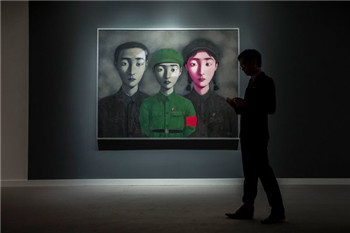(单词翻译:单击)

China’s once-booming art market has slowed significantly in recent years, held back by a sluggish economy and a nationwide crackdown on corruption. But that has not dampened the hopes of aspiring gallery owners, antiques traders and artists across China. Next month, Tsinghua University in Beijing, in collaboration with Sotheby’s, will welcome 60 students for a two-year master’s degree program in the business of art, the first of its kind in China.The inaugural class includes students from mainland China, Hong Kong and Taiwan, many of them employees of museums, galleries and art magazines. Tsinghua and Sotheby’s have promised “privileged access to some of the world’s finest collections and works of art.” Classes will be held in Beijing, London and New York. In an interview, Zhang Gan, vice dean of Tsinghua’s Academy of Arts and Design and a leader of the Tsinghua-Sotheby’s initiative, discussed the new program and the ups and downs of China’s art market.
近些年来,经济的放缓和全国范围的反腐行动导致中国一度繁荣的艺术市场发展大幅减速。但这没有降低中国各地怀有抱负的画廊老板、古董交易商和艺术家的希望。下个月,北京的清华大学将与苏富比拍卖行(Sotheby's)合作,欢迎60名学生加入为期两年的艺术管理硕士专业学位课程,这是中国首个相关课程。首批入学的包括来自中国内地、香港和台湾的学生,其中很多人是博物馆、画廊和艺术杂志的工作人员。清华和苏富比承诺学员“有机会接触世界上最好的收藏和艺术品。”课程将在北京、伦敦和纽约开展。”清华大学美术学院副院长、清华-苏富比项目负责人张敢谈论了该新项目,以及中国艺术市场的起起伏伏。
Q. Universities in China have not traditionally offered courses in the business of art. Why is there a need for this program?
问:中国大学没有提供艺术管理课程的传统。为什么会有开设这种课程的需求呢?
A. The fact that China’s art market is so volatile, so prone to bubbles and so full of chaos is very much related to the lack of talent in arts management. As someone who loves art and loves collecting art, I hope China’s market can benefit from professional managers who can help it develop in a healthier, more sustainable way.
答:事实上,中国的艺术市场极不稳定,容易出现泡沫,非常混乱,这与艺术管理人才的缺乏有着非常大的关系。作为一个热爱艺术和艺术品收藏的人,我希望中国市场能够受益于专业的管理人员,他们能帮助艺术市场更加健康、持续的发展。
Q. What impact has the slowing economy had on the art market? Art sales in China have fallen 30 percent since 2011 by some estimates, and the United States has regained the title of the world’s largest art market.
问:经济放缓对艺术市场有什么影响?根据一些人的估计,中国的艺术品销售自2011年以来下降了30%,美国夺回了世界最大艺术市场的称号。
A. It just means there will be fewer people looking for opportunistic investments. I think this will make the art market healthier and the prices more reasonable again. The bubble has burst, but the water is still there.
答:这仅仅意味着寻找投机机会的人变少了。我觉得这会再次让艺术市场变得更加健康,价格更合理。泡沫破灭了,但水还在那里。
Q. The Chinese art trade is plagued by problems such as fraud, corruption and lax regulation. How will you address this in your program?
问:中国的艺术品交易受到欺诈、腐败、监管松懈等问题的困扰。你们的课程如何应对这个问题呢?
A. Such topics can’t be avoided because they exist in China’s art market. That’s the reason China needs professional art managers. I think higher education is a good opportunity to inject a dose of idealism in students. The course will teach them that a healthy and sustainable art market benefits everyone and an opportunistic market is harmful for everyone involved.
答:这样的话题无法避免,因为中国艺术市场存在这些问题。因此中国需要专业的艺术管理人员。我觉得,高等教育是一个很好地向学生灌输理想主义的机会。相关课程会教他们了解,健康、可持续的艺术市场对每个人都有利,而投机市场对每个人都有害。
Q. What are the most common misperceptions of the Chinese art market?
问:对中国艺术市场最常见的误解是什么?
A. People in China believe that it is an easy way of making money and that it is easy to buy and immediately sell a piece of art for double or triple the price. That does a lot of harm to the market. I believe that each piece has a relatively stable value and the price shouldn’t be too much more or less than that.
答:中国人认为这是一个非常容易的赚钱方式。买入一件艺术品后,立即以两三倍的价格卖出是件很容易的事情。这对市场非常不利。我认为,每件艺术品应该有相对稳定的价值,价格不应该过高或过低。
Q. What can Chinese students learn from institutions like Sotheby’s about the art market in the West?
问:中国学生能通过苏富比等机构对西方艺术市场有什么了解呢?
A. Over the past few hundred years, the art market in the West has matured and become less volatile. The economy goes through booms and busts, but the prices for art stay stable and rational. The price of artwork makes sense in the West. The middle class can often afford it.
答:在过去几百年中,西方艺术市场不断成熟,不稳定性降低。经济经历了繁荣与萧条,但艺术品价格保持稳定、合理。在西方,艺术品的价格是有道理的。往往中产阶级也能够买得起。
Q. You’ve said Western contemporary art and Chinese contemporary art are becoming more closely related. How so?
问:你曾说过西方当代艺术与中国当代艺术的关系日益密切。为什么这么说?
A. China’s contemporary art scene only started in the 1980s, when China began opening up. Chinese artists saw Western art, which released a great deal of creative energy in the mainland. Contemporary artists in China started learning and imitating contemporary artists in the West. But I believe China’s contemporary art is now developing its own unique character.
答:中国的当代艺术市场从20世纪80年代才起步,那时候中国开始开放。中国艺术家看到了西方艺术,西方艺术在内地释放了大量的创造力。中国的当代艺术家开始学习、模仿西方的当代艺术家。但我认为中国的当代艺术现在已经形成了自己的特点。
Q. What do you expect your students will do after graduating? Are there jobs for them in China, or is the market still developing?
问:你觉得你的学生们在毕业后会做什么工作?中国有适合他们的工作吗,或中国的艺术市场仍在发展吗?
A. I think most of our students want to start their own gallery or business after graduating. They are people of financial means. Whether there will be enough jobs in China’s art market is a good question. Our program will graduate 60 students a year, or 600 students in a decade. If each graduate opens a gallery and represents 10 artists, that totals 6,000 artists. Does China have 6,000 good artists? We’ll see. They can’t all be running galleries.
答:我觉得大部分学生希望在毕业后会开办自己的画廊或创业。他们都有获取资金的方法。中国艺术市场是否有足够多的就业机会是个好问题。我们的项目每年会有60名毕业生,或者说10年会有600名毕业生。如果每个毕业生开办一家画廊,代理10名艺术家,那总共会有6000名艺术家。中国有6000名优秀的艺术家吗?我们拭目以待吧。他们不会全都开画廊。


